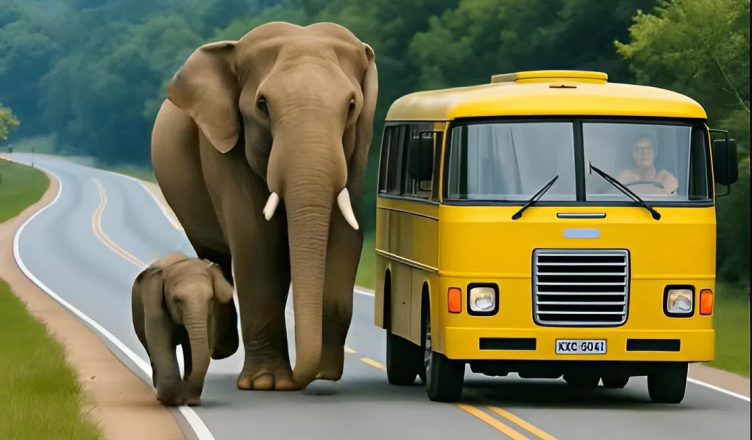It was supposed to be just another quiet day. The long-distance bus cruised steadily down a forest highway, weaving between lush greenery under the heavy summer heat. The road stretched ahead, smooth and predictable. Passengers slouched in their seats — some dozing, some listening to music, others silently reading or watching the trees flicker past the windows.
Nothing out of the ordinary. Until the driver hit the brakes.
Up ahead, two massive shapes stood in the middle of the road. As the vehicle rolled closer, the driver squinted through the shimmering haze of heat. It was an adult elephant. And beside her — a small calf, barely reaching her knee.
At first, it looked like a peaceful sight. Wild animals sometimes wandered near the road, especially in forest regions. But something was off.
The elephant wasn’t calmly grazing. She was moving erratically, swinging her head, flapping her ears, pacing back and forth across the asphalt. Her massive body blocked the entire lane, and her eyes — dark, focused, intense — were locked on the approaching vehicle.
Passengers began to stir. Some pointed, others gasped. A few shouted. Panic started to ripple through the bus. The driver hesitated. Elephants were powerful and unpredictable. If this one charged…
Then, something unexpected happened.
The elephant didn’t charge. Instead, she stomped her feet, raised her trunk toward the vehicle, and let out a guttural cry. It wasn’t a warning — it sounded like a plea.
People inside the bus froze. A woman grabbed her child. A man reached for his phone. Someone muttered, “She’s going to attack.”
But just then, a middle-aged passenger in the front row, who had been watching with binoculars, suddenly screamed:
“LOOK — in the ditch! Over there! Something’s trapped!”
Heads turned. On the right side of the road, behind a curtain of bushes, something dark and still was barely visible. The driver cautiously stepped out, moving slowly toward the ditch.

And there, caught between two slabs of broken concrete, lay another baby elephant — smaller than the first. Its front leg was pinned. The little body trembled with exhaustion, its breathing labored. It had clearly been struggling for hours.
Everything made sense now. The mother elephant hadn’t been threatening. She had been asking for help.
For the next few seconds, the scene was surreal. The same people who moments ago feared being trampled were now rushing out of the bus. Men ran toward the ditch. Someone started calling wildlife rescue services. Others grabbed water bottles, wet cloths. A few formed a human chain to clear the area.
Within thirty minutes, forest rangers arrived. But the elephant stayed close, circling the trapped calf, occasionally reaching toward it with her trunk. She never attacked. She waited.
It took nearly two hours of careful maneuvering to free the baby without causing further injury. The whole time, the mother watched, never once moving too far, yet never interfering. Her body was tense, but her eyes — alert and hopeful.
When the final slab was lifted and the calf rolled free, it didn’t stand right away. For ten long minutes it lay still, then slowly pushed itself up. Staggering, it took a few shaky steps toward its mother. The moment their trunks touched, a soft trumpet echoed through the trees.
And then something happened that no one would forget.
The mother elephant turned toward the group of people. She looked directly at them. And then — slowly, deliberately — she lowered her head.
A subtle gesture. Barely noticeable. But everyone present felt it in their chest.
“She’s saying thank you,” someone whispered.
And perhaps she was.
The two elephants, mother and calf, disappeared into the trees. The road was quiet again, but nothing felt the same. The passengers stood silently, some with tears in their eyes. No one spoke. No one wanted to break the spell.
The video of the incident, captured on a passenger’s phone, quickly went viral. News outlets picked up the story, praising the courage and compassion of both the elephant and the people. But beyond headlines, what resonated most was the raw emotion of the moment — the unspoken bond that had formed between species.
Because this wasn’t just a rescue. It was a testament to understanding, to instinct, to maternal love that transcends language and biology.
On that forest road, one mother’s cry for help was heard — and answered. And in doing so, a group of strangers were forever changed.
